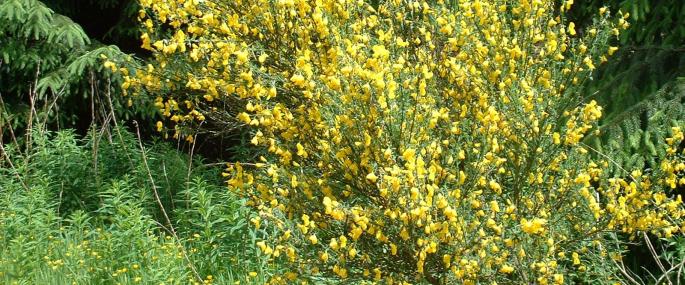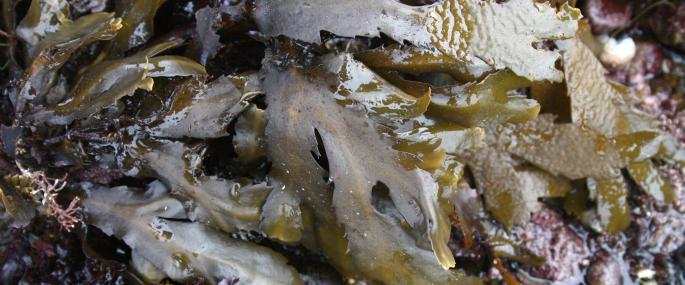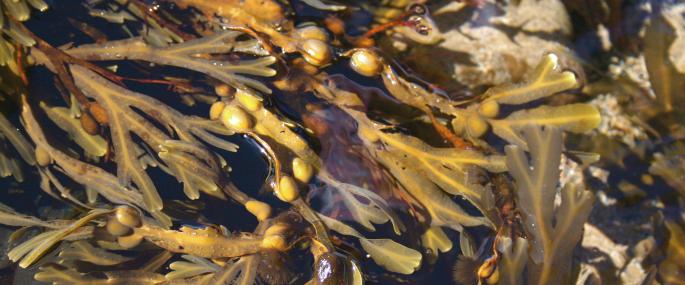Buddleia
Buddleia is a popular garden plant which was introduced into the UK from China in the 1890s and has now become widely naturalised on waste ground, along railway lines and in towns. Its familiar purple flowers bloom from June to October and attract all kinds of butterflies and moths looking for nectar sources, particularly in urban areas. Its winged seeds and dispersed by the wind and find it easy to colonise stony ground.
Although Buddleia is an introduced species, it has become an important nectar source for many species of butterfly and moth, especially in urban areas where natural habitats have been lost and gardens are now important corridors for wildlife moving about the country. Plant Buddleia in your garden and enjoy watching who comes fluttering by for a drink... To find out more about wildlife-friendly gardening, visit our Wild About Gardens website: a joint initiative with the RHS, there's plenty of facts and tips to get you started.

Sea-buckthorn
Sea-buckthorn is a very spiny shrub, native to sand dunes along the east coast of England, but planted in other areas to help stabilise dune systems. It forms dense thickets with thorny twigs and, although it has small green flowers, is most noticeable in the autumn when it displays an abundance of bright orange berries.
Sea-buckthorn is an important shrub in coastal sand dune systems, helping to stabilise the dunes and providing food and shelter for wildlife, including birds like Fieldfares. The Wildlife Trusts look after many coastal habitats and are working closely with farmers, landowners and developers to promote wildlife-friendly practices in these areas. We have a vision of a 'Living Landscape': a network of habitats and wildlife corridors across town and country, which are good for both wildlife and people. You can support this greener vision for the future by joining your local Wildlife Trust.

Dog-rose
Dog-rose is a scrambling shrub, found in hedgerows, woodland edges, on sand dunes and grasslands. It is the most abundant of our native, wild roses, with sweet-scented pink or white flowers that appear in June and July. In the autumn, it produces bright red rosehips that are often eaten by birds and small mammals such as bank voles.
Dog-rose is an important shrub in the wild, providing shelter and food for wildlife, but it can also be a useful plant in your garden too - the nectar-filled flowers attract many insects which, in turn, attract birds that prey on them, and the rosehips attract small mammals. Try planting a few shrubs in your garden and see who comes to visit... To find out more about wildlife-friendly gardening, visit our Wild About Gardens website: a joint initiative with the RHS, there's plenty of facts and tips to get you started.
Broom
Broom is a large, deciduous shrub, similar in appearance to Gorse, but without the spines. This member of the pea family is common on heaths, in open woodlands and along hedgerows and can be found at the coast. Its bright yellow flowers appear in spring, from April to June, and smell of vanilla. It is quite likely that Broom got its name from the fact that its long, whip-like stems were cut and tied together to make brushes. Although a number of similar species were also used in this way, Broom created the best brooms!
Broom is an important shrub in the wild, providing shelter and food for wildlife, but it can also be a useful plant in your garden too - the nectar-filled flowers attract many insects which, in turn, attract birds that prey on them. Try planting a few shrubs in your garden and see who comes to visit... To find out more about wildlife-friendly gardening, visit our Wild About Gardens website: a joint initiative with the RHS, there's plenty of facts and tips to get you started.

Gorse
Windy, open moors or coastal grasslands covered in bright yellow Gorse and purple heathers are synonymous with what we call 'wild' landscapes. Yet Gorse can be seen in all kinds of habitats from heaths and commons to towns and gardens. It generally flowers from January to June (although it may flower sporadically throughout the year), while its close relatives - Western Gorse and Dwarf Gorse - flower from July to November. Gorse is a member of the pea family.
Gorse is an important shrub as it provides shelter and food for many insects and birds, such as Dartford Warblers, Stonechats and Yellowhammers. However, it can quickly become invasive in an area, forming dense, impenetrable stands. The Wildlife Trusts manage many heathland and grassland habitats for the benefit of wildlife - careful grazing with traditional breeds and scrub clearance are just a couple of the ways they ensure a balance of plants and cover in these fragile habitats. By volunteering for your local Trust you can help too, and you'll make new friends and learn new skills along the way.
Egg Wrack
Egg Wrack is a common 'wrack' seaweed which grows on sheltered, rocky shores, between the upper and middle shore. It has a tough, leathery appearance but is particularly distinguishable by its air bladders which appear at regular intervals along the fronds. Egg Wrack is a long-lived species, with individuals growing slowly for decades, and fronds often lasting for as long as 15 years before breaking off.
Seaweeds provide a vital link in the food chain for many of our rarer species. Our seas and coastline are in need of protection if we are to keep our marine wildlife healthy. The Wildlife Trusts are working with fishermen, researchers, politicians and local people towards a vision of 'Living Seas', where marine wildlife thrives. This work has recently had a massive boost with the passing of the Marine Bill, promising sustainable development of the UK's marine environment. Do your bit for our Living Seas by supporting your local Wildlife Trust.
Carrageen
Carrageen is a common, small seaweed that grows on rocky shores and in tidal pools and estuaries. Also known as 'Irish Moss', it is harvested commercially for the food and pharmaceutical industries.
Seaweeds provide a vital link in the food chain for many of our rarer species. Our seas and coastline are in need of protection if we are to keep our marine wildlife healthy. The Wildlife Trusts are working with fishermen, researchers, politicians and local people towards a vision of 'Living Seas', where marine wildlife thrives. This work has recently had a massive boost with the passing of the Marine Bill, promising sustainable development of the UK's marine environment. Do your bit for our Living Seas by supporting your local Wildlife Trust.
Purple Laver
Purple Laver is a common seaweed that grows on rocks and stones on sandy shores and can tolerate both air exposure and extreme wave action. It is a red algae that occurs singularly or in colonies, attaching to the substrate with a disc-like holdfast. Purple Laver and other Porphyra species have complex lifecycles which include a microscopic phase that lives in shells.
Seaweeds provide a vital link in the food chain for many of our rarer species. Our seas and coastline are in need of protection if we are to keep our marine wildlife healthy. The Wildlife Trusts are working with fishermen, researchers, politicians and local people towards a vision of 'Living Seas', where marine wildlife thrives. This work has recently had a massive boost with the passing of the Marine Bill, promising sustainable development of the UK's marine environment. Do your bit for our Living Seas by supporting your local Wildlife Trust.
Serrated Wrack
Serrated, 'Saw' or 'Toothed' Wrack is a common 'wrack' seaweed that grows just above the low water mark on sheltered, rocky shores. Its fronds do not have air bladders but have serrated edges, hence the common names.
Serrated Wrack, and other species of seaweed, support a number of epiphytes (plants that grow on other plants) and provide food and shelter for all kinds of shore creatures from grazing molluscs to tiny fish. Our seas and coastline are in need of protection if we are to keep our marine wildlife healthy. The Wildlife Trusts are working with fishermen, researchers, politicians and local people towards a vision of 'Living Seas', where marine wildlife thrives. This work has recently had a massive boost with the passing of the Marine Bill, promising sustainable development of the UK's marine environment. Do your bit for our Living Seas by supporting your local Wildlife Trust.

Bladder Wrack
Probably the seaweed which is most associated with the seashore, Bladder Wrack is a common 'wrack' seaweed which grows between the high and low water marks on rocky shores. Looking a little like dark bubblewrap, Bladder Wrack has round air bladders which allow the seaweed to float upright underwater. On exposed shores, Bladder Wrack has fewer air bladders than on sheltered shores. It can live for about four or five years.
Bladder Wrack, and other species of seaweed, support a number of epiphytes (plants that grow on other plants) and provide food and shelter for all kinds of shore creatures from grazing molluscs to tiny fish. Our seas and coastline are in need of protection if we are to keep our marine wildlife healthy. The Wildlife Trusts are working with fishermen, researchers, politicians and local people towards a vision of 'Living Seas', where marine wildlife thrives. This work has recently had a massive boost with the passing of the Marine Bill, promising sustainable development of the UK's marine environment. Do your bit for our Living Seas by supporting your local Wildlife Trust.
